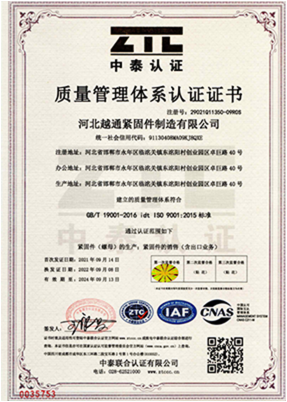Ago . 21, 2024 16:07 Back to list
Various Mechanical Bolt Types and Their Applications in Engineering and Construction
Mechanical Types of Bolts An Overview
Bolts are fundamental components used in mechanical assemblies to fasten various structural elements. They are characterized by their cylindrical shape, with a distinct head at one end and threads along the length of the other. The diverse applications of bolts in engineering and construction dictate the need for various mechanical types, each designed to serve specific purposes while ensuring reliability and strength.
Types of Bolts
1. Hex Bolts One of the most common types of bolts, hex bolts are recognized by their hexagonal heads, which allow for easy tightening with a wrench. They are typically used in structural assemblies and machinery, providing secure fastening in numerous applications. Hex bolts can be found in various grades, with varying tensile strengths, making them versatile for both light and heavy-duty applications.
2. Carriage Bolts Characterized by their round head and square neck, carriage bolts are specifically designed to be used in wood and metal constructions. The square neck prevents the bolt from turning when the nut is tightened, making them ideal for securing wooden components in place. Carriage bolts are commonly used in furniture assembly, construction frames, and outdoor structures like decking.
3. Lag Bolts Often referred to as lag screws, these bolts are designed for heavy-duty fastening, typically in wooden structures. They feature a thick body and coarse threads that create a strong grip within the wood. Lag bolts are frequently used in construction projects, such as securing beams, posts, and heavy brackets.
mechanical types of bolts

4. Shoulder Bolts These bolts have a cylindrical shoulder that acts as a bearing surface. Shoulder bolts are often used in machinery to provide a pivot point or to serve as a hinge. Their unique design allows for minimal friction and enhanced rotation, making them essential in applications where movement and alignment are critical.
5. Socket Head Cap Screws Recognized for their cylindrical heads with a hexagonal socket, socket head cap screws offer superior tensile strength and compactness. They are often used in applications requiring high clamping force, such as in the automotive and aerospace industries. Their design allows for deep engagement with tools, providing a higher torque without the risk of stripping.
6. Eye Bolts Eye bolts are uniquely designed with a loop (or eye) at one end, allowing for the attachment of ropes, chains, or cables. They are commonly used in rigging and lifting applications, providing a secure point for attaching lifting equipment. Eye bolts come in various sizes and load capacities, making them versatile for different lifting scenarios.
7. U-Bolts Shaped like the letter U, these bolts are utilized primarily for securing pipes or other cylindrical objects. U-bolts are commonly used in plumbing and electrical applications, where they help maintain the position of pipes and cables against a surface. They are available in various diameters and lengths to accommodate different loads.
Conclusion
Understanding the various mechanical types of bolts is crucial for engineers and builders alike. Each bolt type serves a distinct purpose and is designed to handle specific loading conditions. Selecting the appropriate bolt type not only ensures structural integrity but also contributes to the overall safety and durability of the assembly. Whether fastening timber, metal structures, or machinery components, the right bolt can make all the difference in achieving a reliable and long-lasting solution in any engineering project.


